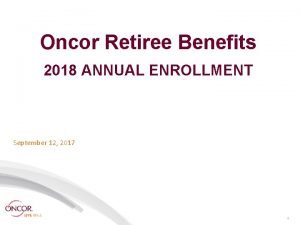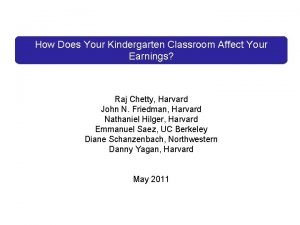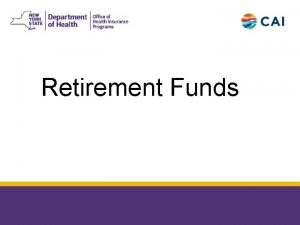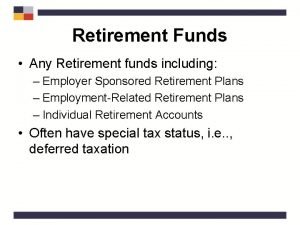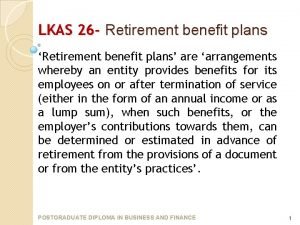Principles for a successful retirement Seven principles for













- Slides: 13

Principles for a successful retirement

Seven principles for a successful retirement q Create the plan you need for the retirement you want q Plan for a long life q Make an informed decision about Social Security q Know what to expect with health care costs q Use time to your advantage q Minimize your taxes to maximize your retirement q Don’t spend too much or invest too conservatively 2 |

| 12 Retirement savings checkpoints MODEL ASSUMPTIONS Assumed annual gross savings rate: 10%* Saving Pre-retirement investment return: 6. 0% Post-retirement investment return: 5. 0% Inflation rate: 2. 25% Retirement age – • Primary earner: 65 • Spouse: 62 Years in retirement: 30 *10% is approximately twice the U. S. average annual savings rate This chart is for illustrative purposes only and must not be relied upon to make investment decisions. J. P. Morgan’s model is based on J. P. Morgan Asset Management’s (JPMAM) proprietary long-term capital market assumptions (10 -15 years) and an 80% confidence level. Household income replacement rates are derived from an inflation-adjusted analysis of: Consumer Expenditure Survey (BLS) data (20112014); Social Security benefits using modified scaled earnings in 2017 for a single wage earner at age 65 and a spousal benefit at age 62 reduced by Medicare Part B premiums. For more details, see slide 14 of the Guide to Retirement. Consult with a financial advisor for a more personalized assessment. Allocations, assumptions and expected returns are not meant to represent JPMAM performance. Given the complex risk/reward tradeoffs involved, we advise clients to rely on judgment as well as quantitative optimization approaches in setting strategic allocations. References to future returns for either asset allocation strategies or asset classes are not promises or even estimates of actual returns a client portfolio may achieve.

Retirement landscape Life expectancy probabilities | 5 PLAN FOR LONGEVITY Average life expectancy continues to increase and is a mid-point not an end-point. You may need to plan on the probability of living much longer perhaps 30+ years in retirement and invest a portion of your portfolio for growth to maintain your purchasing power over time. Chart: Social Security Administration, Period Life Table, 2013 (published in 2016), J. P. Morgan Asset Management. Table: Social Security Administration 2016 OASDI Trustees Report. Probability at least one member of a same-sex female couple lives to age 90 is 55% and a same-sex male couple is 39%.

| 8 Retirement landscape Social Security timing tradeoffs UNDERSTAND THE TRADEOFFS Deciding when to claim benefits will have a permanent impact on the benefit you receive. Claiming before your full retirement age can significantly reduce your benefit, while delaying increases it. In 2017, full retirement age begins to transition from 66 to 67 by adding two months each year for the next six years. This makes claiming early even more of a benefit reduction. For illustrative purposes only. For those born in 1956 or earlier, there is a 7. 3% compound growth rate for each year of waiting to take benefits; 7. 4% for those born in 1957 or after. The Social Security Amendments Act of 1983 increased FRA from 65 to 67 over a 40 -year period. The first phase of transition increased FRA from 65 to 66 for individuals turning 62 between 2000 and 2005. After an 11 -year hiatus, the transition from 66 to 67 (2017 -2022) will complete the move. Source: Social Security Administration, J. P. Morgan Asset Management

| 9 Retirement landscape Maximizing Social Security benefits PLANNING OPPORTUNITY Delaying benefits means increased Social Security income later in life, but your portfolio may need to bridge the gap and provide income until delayed benefits are received. Source: Social Security Administration, J. P. Morgan Asset Management. *Couple assumes at least one lives to the specified age or beyond. Breakeven assumes the same individual, born in 1955, earns the maximum wage base, retires at the end of age 61, and claims at 62 & 1 month, 66 & 2 months and 70, respectively. Benefits are assumed to increase each year based on the Social Security Administration 2016 Trustee’s Report “intermediate” estimates (annual benefit increase of 2. 9% in 2018 and 2. 6% thereafter). Monthly amounts without the cost of living adjustments (not shown on the chart) are: $2, 141 at age 62; $2, 888 at age 66; and $3, 773 at age 70. Exact breakeven ages are 76 & 2 months and 80 & 5 months.

Rising annual health care costs in retirement | 26 A GROWING CONCERN Spending Given variation in health care cost inflation from year to year, it may be prudent to assume an annual health care inflation rate of 6. 5%, which may require growth as well as current income from your portfolio in retirement. Notes: Age 85 estimated total median cost in 2017 is $7, 195. Medigap premiums usually increase due to age, in addition to annual inflation, except for most policies in the following states: AR, CT, MA, ME, MN, NY, VT WA, AZ, FL, ID and MO. Analysis includes Medigap Plan F (the most comprehensive plan). Parts B and D additional premiums are calculated from federal tax returns two years prior; individuals may file for an exception on form SSA 44 if they reduce or stop work. For the definition of MAGI, please see Guide to Retirement slide 36. *Additional premium includes a projection of 2018 costs for a 65 -year-old beneficiary in 2018 ($5, 076), plus the surcharge percentage specified in the Medicare Access and CHIP Reauthorization Act of 2015 ( MACRA / “doc fix bill”). Source: Employee Benefit Research Institute (EBRI) data as of December 31, 2016; Select. Quote data as of January 16, 2017; Centers for Medicare and Medicaid Services website, January 25, 2017; 2016 Medicare Trustees Report, June 22, 2016; J. P. Morgan analysis.

Goals-based wealth management | 30 DIVIDE AND CONQUER Investing Aligning your investment strategy by goal can help you take different levels of risk based on varying time horizons and make sure you are saving enough to accomplish all of your goals—not just the ones that occur first. Source (top chart): J. P. Morgan Asset Management. Source (bottom chart): Barclays Capital, Fact. Set, Federal Reserve, Robert Shiller, Stategas/Ibbotson, J. P. Morgan Asset Management. Returns shown are based on calendar year returns from 1950 to 2016. Stocks represent the S&P 500 Shiller Composite and Bonds represent Stategas/Ibbotson for periods from 1950 to 2010 and Barclays Aggregate thereafter. Note: Portfolio allocations are hypothetical and are for illustrative purposes only. They were created to illustrate different risk/return profiles and are not meant to represent actual asset allocation.

Evaluate a Roth at different life stages | 18 THINK OPPORTUNISTICALLY Saving Effectively managing taxes over a lifetime requires a careful balance of your current income tax picture and building income tax diversification. Consider: 1. Contributing to a Roth early in your career and shifting as your income increases. 2. Roth 401(k) contributions in peak earning years if wealth is concentrated in tax-deferred accounts. 3. Proactive Roth conversions in lower income retirement years if RMDs are likely to push you into a higher tax bracket. *If eligible to make a deductible contribution (based on your MAGI). The illustration reflects savings options into Traditional and Roth IRA accounts, as well as into pre-tax retirement and Roth 401(k) accounts. RMD = Required Minimum Distribution. RMDs are calculated every year based on the account value and the owner’s life expectancy using IRS actuarial data. IRA owners must begin taking RMDs no later than April 1 following the year the owner turns age 70½. For owners of employer-based qualified plans, RMDs must begin at age 70½ or when the owner retires, whichever is later. Owners of Roth IRAs are not required to take RMDs; however, RMDs are required in Roth 401(k) accounts. Any employer contribution will be applied to the participant’s pre-tax retirement account for both Traditional and Roth 401(k) plans, and subsequent distributions will be subject to tax. The above example is for illustrative purposes only. Source: J. P. Morgan Asset Management

Effects of withdrawal rates and portfolio allocations | 21 ONE SIZE DOES NOT FIT ALL Spending Higher initial withdrawal rates or overly conservative portfolios can put your retirement at risk. However, setting your spending at retirement too low and not adjusting along the way may require unnecessary lifestyle sacrifices in retirement. You may want to consider a dynamic approach that adjusts over time to more effectively use your retirement savings. 50 th percentile means that 50% of the time you’ll have better outcomes. Based on the high percentage of outcomes that tend to be clustered near the median, this may be considered the most likely potential outcome. For the 40/60 portfolio at a 4% withdrawal rate, the real portfolio value at period 30 is $212, 029 vs. $413, 328 nominal. These charts are for illustrative purposes only and must not be used, or relied upon, to make investment decisions. Portfolios are described using equity/bond denotation (e. g. a 40/60 portfolio is 40% equities and 60% bonds). Hypothetical portfolios are composed of US Large Cap for equity, US Aggregate Bonds and US Cash for cash, with compound returns projected to be 6. 25%, 3. 00% and 2. 00%, respectively. J. P. Morgan’s model is based on J. P. Morgan Asset Management’s (JPMAM) proprietary Long-Term Capital Markets Assumptions (10– 15 years). The resulting projections include only the benchmark return associated with the portfolio and does not include alpha from the underlying product strategies within each asset class. The yearly withdrawal amount is set as a fixed percentage of the initial amount of $1, 000 and is then inflation adjusted over the period (2. 25%). Allocations, assumptions and expected returns are not meant to represent JPMAM performance. Given the complex risk/reward tradeoffs involved, we advise clients to rely on judgment as well as quantitative optimization approaches in setting strategic allocations. References to future returns for either asset allocation strategies or asset classes are not promises or even estimates of actual returns a client portfolio may achieve.

Seven principles for a successful retirement q Create the plan you need for the retirement you want q Plan for a long life q Make an informed decision about Social Security q Know what to expect with health care costs q Use time to your advantage q Minimize your taxes to maximize your retirement q Don’t spend too much or invest too conservatively 11 |

J. P. Morgan Asset Management—Index definitions & disclosures Indexes are unmanaged an individual cannot invest directly in an index. Index returns do not include fees or expenses. The S&P 500 Index is widely regarded as the best single gauge of the U. S. equities market. The J. P. Morgan Emerging Markets Bond Index Global Diversified (EMBI Global Diversified) tracks total returns for U. S. dollar-denominated debt instruments issued by emerging market sovereign and quasi-sovereign entities: Brady bonds, loans, Eurobonds. The index limits the exposure of some of the larger countries. The Russell 2000 Index® measures the performance of the 2, 000 smallest companies in the Russell 3000 Index. The Bloomberg Commodity Index is composed of futures contracts on physical commodities and represents 22 separate commodities traded on U. S. exchanges, with the exception of aluminum, nickel and zinc. The MSCI Emerging Markets Index is a free float-adjusted market capitalization index that is designed to measure equity market performance in the global emerging markets. As of June 2007, the MSCI Emerging Markets Index consisted of the following 25 emerging market country indices: Argentina, Brazil, Chile, China, Colombia, Czech Republic, Egypt, Hungary, India, Indonesia, Israel, Jordan, Korea, Malaysia, Mexico, Morocco, Pakistan, Peru, Philippines, Poland, Russia, South Africa, Taiwan, Thailand Turkey. Reference The Barclays US High Yield Index covers the universe of fixed rate, noninvestment grade debt. Eurobonds and debt issues from countries designated as emerging markets (sovereign rating of Baa 1/BBB+ and below using the middle of Moody’s, S&P and Fitch) are excluded, but Canadian and global bonds (SEC registered) of issuers in non-EMG countries are included. This world-renowned index includes a representative sample of 500 leading companies in leading industries of the U. S. economy. Although the S&P 500 Index focuses on the large cap segment of the market, with approximately 75% coverage of U. S. equities, it is also an ideal proxy for the total market. An investor cannot invest directly in an index. The MSCI EAFE (Europe, Australia, Far East) Net Index is recognized as the pre-eminent benchmark in the United States to measure international equity performance. It comprises 21 MSCI country indexes, representing the developed markets outside of North America. 12 | The FTSE NAREIT EQUITY REIT Index is designed to provide the most comprehensive assessment of overall industry performance and includes all taxqualified real estate investment trusts (REITs) that are listed on the NYSE, the American Stock Exchange or the NASDAQ National Market List. The Barclays Capital U. S. Aggregate Index represents securities that are SECregistered, taxable and dollar denominated. The index covers the U. S. investment-grade fixed rate bond market, with index components for government and corporate securities, mortgage pass-through securities and asset-backed securities. These major sectors are subdivided into more specific indexes that are calculated and reported on a regular basis. The Barclays Global High Yield Index is a multi-currency flagship measure of the global high yield debt market. The index represents the union of the US High Yield, the Pan-European High Yield and Emerging Markets (EM) Hard Currency High Yield Indices. The high yield and emerging markets sub-components are mutually exclusive. Until January 1, 2011, the index also included CMBS high yield securities. Unless otherwise indicated, all illustrations are shown in U. S. dollars. Past performance is no guarantee of comparable future results. Diversification does not guarantee investment returns and does not eliminate the risk of loss. Bonds are subject to interest rate risks. Bond prices generally fall when interest rates rise. The price of equity securities may rise or fall because of changes in the broad market or changes in a company's financial condition, sometimes rapidly or unpredictably. These price movements may result from factors affecting individual companies, sectors or industries, or the securities market as a whole, such as changes in economic or political conditions. Equity securities are subject to "stock market risk, " meaning that stock prices in general may decline over short or extended periods of time. Small capitalization investing typically carries more risk than investing in wellestablished "blue-chip" companies since smaller companies generally have a higher risk of failure. Historically, smaller companies' stock has experienced a greater degree of market volatility than the average stock. Mid capitalization investing typically carries more risk than investing in wellestablished "blue-chip" companies. Historically, mid cap companies' stock has experienced a greater degree of market volatility than the average stock.

J. P. Morgan Asset Management—Disclosures Real estate investments may be subject to a higher degree of market risk because of concentration in a specific industry, sector or geographical sector. Real estate investments may be subject to risks including, but not limited to, declines in the value of real estate, risks related to general and economic conditions, changes in the value of the underlying property owned by the trust and defaults by borrower. Opinions and estimates offered constitute our judgment and are subject to change without notice, as are statements of financial market trends, which are based on current market conditions. We believe the information provided here is reliable, but do not warrant its accuracy or completeness. References to future returns are not promises or even estimates of actual returns a client portfolio may achieve. International investing involves a greater degree of risk and increased volatility. Changes in currency exchange rates and differences in accounting and taxation policies outside the U. S. can raise or lower returns. Also, some overseas markets may not be as politically and economically stable as the United States and other nations. This document is a general communication being provided for informational purposes only. It is educational in nature and not designed to be a recommendation for any specific investment product, strategy, plan feature or other purpose. Any examples used are generic, hypothetical and for illustration purposes only. Prior to making any investment or financial decisions, an investor should seek individualized advice from a personal financial, legal, tax and other professional advisors that take into account all of the particular facts and circumstances of an investor’s own situation. Investments in emerging markets can be more volatile. As mentioned above, the normal risks of investing in foreign countries are heightened when investing in emerging markets. In addition, the small size of securities markets and the low trading volume may lead to a lack of liquidity, which leads to increased volatility. Also, emerging markets may not provide adequate legal protection for private or foreign investment or private property. Reference Investments in commodities may have greater volatility than investments in traditional securities, particularly if the instruments involve leverage. The value of commodity-linked derivative instruments may be affected by changes in overall market movements, commodity index volatility, changes in interest rates or factors affecting a particular industry or commodity, such as drought, floods, weather, livestock disease, embargoes, tariffs and international economic, political and regulatory developments. Use of leveraged commodity-linked derivatives creates an opportunity for increased return but, at the same time, creates the possibility for greater loss. 13 | Investing in alternative assets involves higher risks than traditional investments and is suitable only for sophisticated investors. Alternative investments involve greater risks than traditional investments and should not be deemed a complete investment program. They are not tax efficient and an investor should consult with his/her tax advisor prior to investing. Alternative investments have higher fees than traditional investments and they may also be highly leveraged and engage in speculative investment techniques, which can magnify the potential for investment loss or gain. The value of the investment may fall as well as rise and investors may get back less than they invested. JPMorgan Distribution Services, Inc. , member FINRA / SIPC. J. P. Morgan Asset Management is the marketing name for the asset management businesses of JPMorgan Chase & Co. and its affiliates worldwide. Copyright © 2017 JPMorgan Chase & Co. All rights reserved. Material ID # 4 eb 797 d 0 -07 fb-11 e 7 -97 da-005056960 c 8 a NOT FDIC INSURED. NO BANK GUARANTEE. MAY LOSE VALUE.
 Seven heavenly virtues
Seven heavenly virtues Belinda doyle
Belinda doyle Ywca retirement fund
Ywca retirement fund William shakespeare retirement
William shakespeare retirement State of alaska retirement
State of alaska retirement Nancy invested 6000 in a bond
Nancy invested 6000 in a bond Bob carlson retirement watch
Bob carlson retirement watch Oncorretirees.com
Oncorretirees.com Montana teacher retirement
Montana teacher retirement Momiji retirement home
Momiji retirement home Retirement savings percentile
Retirement savings percentile Retirement services fort bragg
Retirement services fort bragg Retirement stage of family life cycle
Retirement stage of family life cycle Tcg retirement
Tcg retirement







